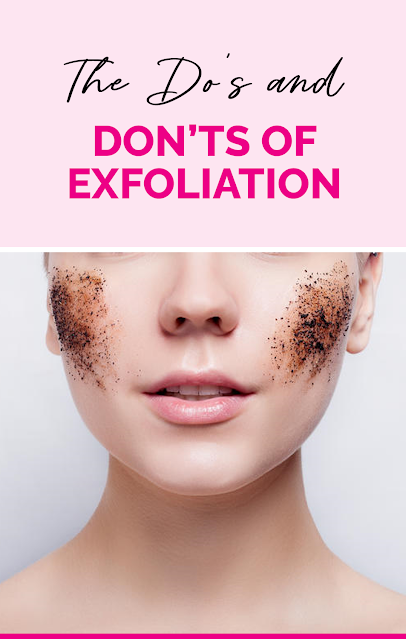The term "exfoliation" has become indispensable in the field of skincare. Exfoliation, for the uninitiated, is the procedure of removing dead skin cells from the skin's surface to reveal a layer of new, fresh cells beneath. The outcome is a more radiant, supple, and healthy complexion. Exfoliation is more complex than it first appears, despite how straightforward it may seem. Your skin can be harmed by both too much and too little. With the help of this comprehensive guide, you can maximize the advantages of exfoliation while avoiding pitfalls.
Understanding Exfoliation
Skin is a living organ, continuously generating new cells at its base (the dermis). The new cells travel to the surface (epidermis), where they gradually die and fill with keratin (protein), serving as your body's primary defense against the environment. Over time, these cells shed to make room for the newer cells.
Natural exfoliation, or desquamation, happens in everybody. However, its efficiency can decline with age, skin type, and various other factors, leading to a buildup of dead skin cells. This buildup can result in a dull complexion, clogged pores, and uneven skin texture. This is where manual exfoliation steps in to enhance your skin's natural process.
Types of Exfoliation
Exfoliation methods can be categorized into two main types: physical and chemical.
- Physical Exfoliation: This involves using a tool (like a brush or sponge) or a scrub (containing small particles) to physically remove dead skin cells.
- Chemical Exfoliation: This involves using products containing special kinds of acids that dissolve dead skin cells without the need for scrubbing.
Now that we have a basic understanding of exfoliation let's delve into the dos and don’ts.
The Dos of Exfoliation
- Do Understand Your Skin Type: Before you begin exfoliating, it's essential to understand your skin type. Those with oily or thicker skin may be able to withstand more frequent exfoliation, while those with sensitive or dry skin may need to exfoliate less often. It's always best to consult a dermatologist to determine the right exfoliation routine for your skin type.
- Do Choose the Right Exfoliant: The choice between a physical and chemical exfoliant should be based on your skin type and sensitivity. Generally, for sensitive skin, gentle chemical exfoliants like lactic acid or PHA (polyhydroxy acids) are recommended. For oily and acne-prone skin, BHA (beta hydroxy/salicylic acid) is preferred. For normal to combination skin, AHA (alpha hydroxy/glycolic acid) works well.
- Do Start Slow: If you're new to exfoliation, start slowly. Begin with once or twice a week, and observe how your skin reacts. If your skin tolerates it well, gradually increase the frequency.
- Do Moisturize After Exfoliating: Exfoliation can leave your skin dry. Apply a good moisturizer immediately after exfoliating to replenish hydration and prevent dryness and irritation.
- Do Protect Your Skin from the Sun: Exfoliation makes your skin more sensitive to the sun. Always apply a broad-spectrum sunscreen of at least SPF 30 during the day, even if you're staying indoors.
The Don'ts of Exfoliation
- Don't Over-Exfoliate: Over-exfoliation can strip your skin of its natural oils, leading to dryness, sensitivity, and irritation. As a general rule, avoid exfoliating more than two to three times a week.
- Don't Ignore Your Skin's Response: Pay attention to how your skin reacts to exfoliation. Redness, irritation, dryness, or increased sensitivity can be signs that you're exfoliating too much or using the wrong type of exfoliant.
- Don't Use Dirty Tools: If you're using a tool for physical exfoliation like a brush or sponge, ensure it's clean and dry before each use to prevent bacterial contamination. Replace these tools regularly.
- Don't Exfoliate Irritated or Damaged Skin: If your skin is sunburned, irritated, or damaged, give it time to heal before you exfoliate.
- Don't Ignore Your Body: While the face often gets all the attention, don't forget about the rest of your body. Areas like the chest, back, arms, and legs can benefit from regular exfoliation.
Conclusion
Exfoliation is a powerful tool in your skincare arsenal. When done correctly, it can give you a radiant, smooth, and youthful complexion. However, each person's skin is unique, and what works for one might not work for another. Listen to your skin, respect its needs, and adjust your exfoliation routine accordingly.
If you're unsure about any aspect of exfoliation, never hesitate to consult a dermatologist or skincare professional. They can provide tailored advice based on your specific skin type and conditions.
Exfoliation is not just a skincare step; it's a commitment to your skin's health and wellbeing. Be patient, consistent, and informed in your approach, and your skin will thank you. After all, at the end of the day, your skin is a reflection of the care you give it. Happy exfoliating!
